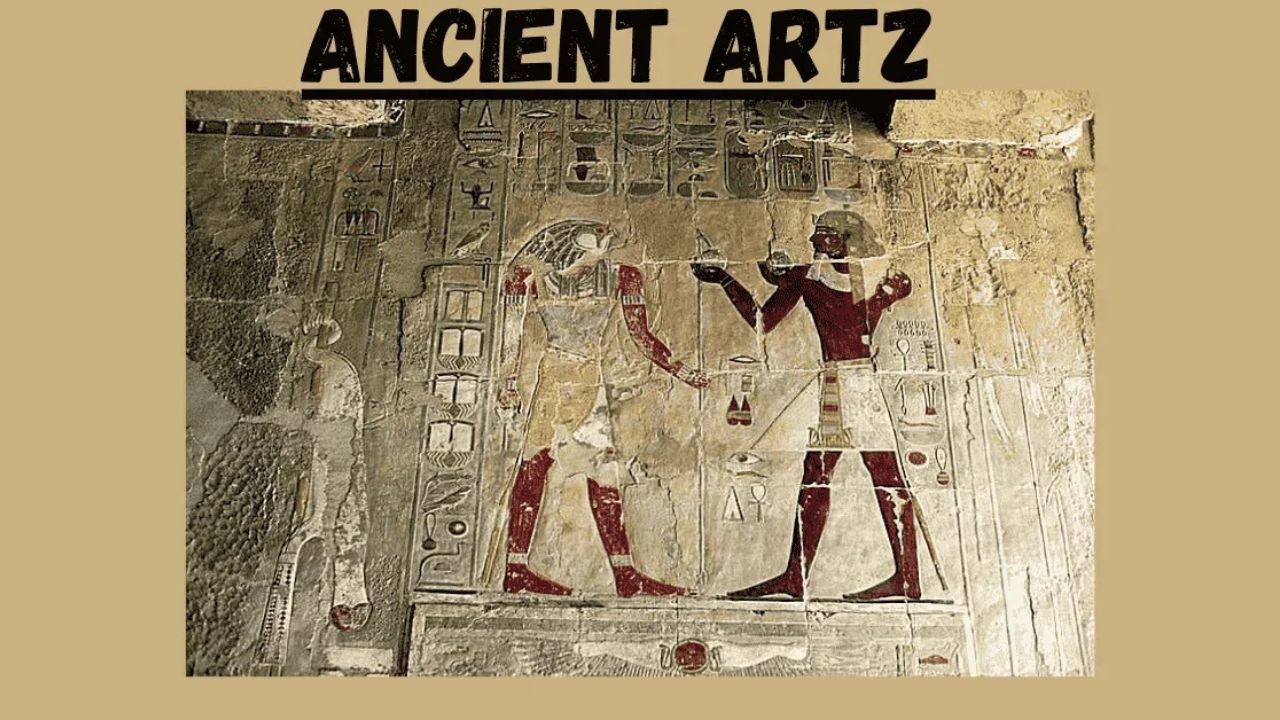Imagine standing in front of a massive stone sculpture, chiselled thousands of years ago, yet still echoing the voices and stories Ancient Artz civilizations. The realm of ancient art is vast, intricate, and deeply rooted in the cultural narratives of its time. For anyone fascinated by history, art, or culture, understanding these ancient techniques and traditions is like holding a key to the past. This blog post will explore the diverse and rich world of ancient art, offering insights into the techniques and traditions that have shaped civilizations over millennia.
The Significance of Ancient Art
Ancient art is not just about aesthetic appeal; it’s a window into the beliefs, values, and daily lives of people from long ago. This art was a form of communication, used to convey stories, celebrate triumphs, and even mourn losses. Understanding ancient art helps us appreciate how cultures evolved and influenced one another over time.
For young readers with a burgeoning interest in history or art, exploring ancient art can be an exciting adventure. From cave paintings that narrate tales of survival and community to monumental structures that demonstrate architectural prowess, Ancient Artz every piece of ancient art tells a story waiting to be uncovered. The study of these artworks also reveals the common threads that connect us to our ancestors, highlighting universal human experiences.
In this blog post, we’ll take a closer look at some of the most iconic ancient art forms and techniques, examining how they were created and what they tell us about the civilizations that produced them. Whether you’re a student, an art enthusiast, Ancient Artz or simply curious about the past, you’ll find plenty of fascinating insights and discoveries here.
The Dawn of Artistic Expression
The earliest known forms of art date back to prehistoric times when humans began to leave their mark on the world. Cave paintings are among the most famous examples of this early artistic expression. These paintings, found in caves across the globe, Ancient Artz depict animals, hunting scenes, and abstract symbols. They provide a glimpse into the minds of early humans, revealing what was important to them and how they interacted with their environment.
Creating these paintings required simple yet effective tools and materials. Natural pigments, often derived from minerals and plants, were mixed with binders like animal fat or water to create paint. Brushes made from animal hair were used to apply the paint, Ancient Artz while fingers and sticks were employed for more detailed work. These techniques, though rudimentary, laid the groundwork for future artistic endeavors.
For those studying ancient art, cave paintings offer an invaluable resource for understanding the origins of human creativity. They show us that even in prehistoric times, people had a deep desire to express themselves and document their experiences. The themes and subjects of these paintings also provide insights into the social and cultural dynamics of early human societies, Ancient Artz highlighting the importance of storytelling and communal activities.
The Birth of Sculpture
Sculpture is another ancient art form that has left an indelible mark on history. From small figurines carved out of stone to grand statues that tower over us today, sculptures have been used to commemorate deities, celebrate leaders, and convey complex narratives. Ancient civilizations like the Egyptians, Greeks, Ancient Artz and Romans were particularly renowned for their sculptural achievements.
Carving stone, metal, or wood into intricate shapes required immense skill and patience. Sculptors relied on tools such as chisels, hammers, and knives to shape their materials with precision. Techniques like bas-relief, where figures are carved into a flat surface, and in-the-round, where sculptures are fully three-dimensional, allowed artists to create stunning works that captured the essence of their subjects.
The study of ancient sculpture offers valuable insights into the cultural and religious beliefs of past societies. Statues of gods and goddesses, for example, reveal how ancient peoples viewed their deities and what attributes they associated with them. Similarly, portrait sculptures of rulers and important figures highlight the values and ideals that were celebrated within these societies, providing us with a deeper understanding of their worldviews.
The Art of the Written Word
Writing is an essential component of art that has played a crucial role in shaping civilizations. Ancient writing systems, such as cuneiform and hieroglyphs, were developed to record information, convey messages, and preserve cultural heritage. These scripts, often inscribed on clay tablets, stone, or papyrus, offer a wealth of information about the societies that created them.
The process of writing in ancient times was a meticulous and labor-intensive task. Scribes used reed pens or brushes to inscribe characters on various surfaces, while ink was made from natural pigments mixed with water or oil. The development of writing also led to the creation of illuminated manuscripts and calligraphy, which elevated writing to an art form in its own right.
Exploring ancient writing systems provides valuable insights into the intellectual and cultural life of early civilizations. These texts offer glimpses into everything from legal codes and religious beliefs to daily life and personal correspondence. By studying ancient writings, we can better understand how societies organized themselves, communicated ideas, and transmitted knowledge across generations.
Architectural Marvels of the Ancient World
Architecture is another art form that has left a lasting legacy on human history. Ancient civilizations constructed monumental structures that have stood the test of time, showcasing their engineering prowess and artistic vision. From the pyramids of Egypt to the temples of Greece, these architectural marvels continue to captivate and inspire us today.
The construction of these structures required advanced knowledge of mathematics, physics, and engineering. Architects and builders employed various techniques, such as post-and-lintel and corbelling, to create stable and durable buildings. They also incorporated decorative elements like columns, friezes, and sculptures to enhance the aesthetic appeal of their creations.
Studying ancient architecture provides insights into the technological advancements and cultural priorities of past societies. These structures often served as centers of religious, political, or social life, reflecting the values and beliefs of their creators. By examining the design and function of these buildings, we can gain a deeper understanding of the civilizations that built them and the legacies they left behind.
The Influence of Religion on Art
Religion has been a powerful force in shaping art throughout history. Many ancient artworks were created to honor deities, depict religious narratives, or facilitate spiritual practices. Temples, shrines, and altars were adorned with intricate carvings, frescoes, and mosaics, serving as visual manifestations of faith.
The interplay between art and religion is evident in the iconography and symbolism found in ancient artworks. Artists often employed specific motifs, colors, and forms to convey religious messages and evoke spiritual experiences. For example, the use of gold leaf in Byzantine mosaics symbolized divine light, while the lotus flower in Hindu and Buddhist art represented purity and enlightenment.
Understanding the relationship between art and religion in ancient times allows us to appreciate the profound impact of spirituality on human creativity. It also highlights the ways in which art was used to communicate complex ideas and emotions, bridging the gap between the material and spiritual worlds. For those interested in the history of religion or art, exploring this intersection offers a rich and rewarding field of study.
The Legacy of Ancient Art in Modern Times
Ancient art continues to influence contemporary artists and art movements, serving as a source of inspiration and innovation. Elements of ancient techniques, styles, and motifs can be found in various forms of modern art, from painting and sculpture to architecture and design. This enduring legacy demonstrates the timeless appeal and relevance of ancient art in today’s world.
Many modern artists draw inspiration from ancient art by reinterpreting traditional themes and techniques in new and innovative ways. For example, contemporary sculptors may experiment with materials and forms to create works that echo the grandeur of ancient statues while conveying modern messages. Similarly, architects may incorporate classical elements like columns and arches into their designs, paying homage to the past while addressing contemporary needs.
Exploring the connections between ancient and modern art offers valuable insights into the evolution of artistic expression and the ways in which cultural heritage informs contemporary creativity. It also highlights the importance of preserving and studying ancient art, ensuring that future generations can continue to learn from and be inspired by these timeless masterpieces.
Conclusion
The world of ancient art is a treasure trove of stories, techniques, and traditions that have shaped civilizations throughout history. From the earliest cave paintings to monumental architectural marvels, these artworks offer invaluable insights into the beliefs, values, and daily lives of our ancestors. By exploring the diverse and rich world of ancient art, we can better appreciate the common threads that connect us to our past and inspire our future creativity.
For those interested in further exploring the fascinating realm of ancient art, there are countless resources available, from books and documentaries to museum exhibitions and online courses. Whether you’re a student, an art enthusiast, or simply curious about history, there’s always more to discover and learn.
In this blog post, we’ve only scratched the surface of the vast and intricate world of ancient art. By continuing to study and engage with these timeless masterpieces, we can deepen our understanding of the human experience and foster a greater appreciation for the creativity and ingenuity that have shaped our world.
FAQs
1. Why is ancient art important to study today?
Ancient art is crucial to study because it provides profound insights into the cultures that created them, revealing their beliefs, values, and social structures. Additionally, ancient art influences modern art and architecture, serving as a source of inspiration and innovation.
2. How does ancient architecture differ from modern architecture?
While ancient architecture often celebrated monumental structures and intricate designs using limited technology, modern architecture employs advanced technology and diverse materials to focus on functionality and minimalist aesthetics. Despite these differences, many modern architects draw on classical elements as a nod to historical achievements.
3. What materials were commonly used in ancient art?
Common materials used in ancient art include stone, clay, metal, wood, and pigments derived from natural sources. These materials were used to create sculptures, paintings, and other art forms, often reflecting the available resources and technological advancements of the time.
4. How has religion influenced ancient art?
Religion influenced ancient art significantly by driving artists to create works that honored deities, depicted religious tales, and fostered spiritual practices. This intersection is evident in the symbolic motifs, forms, and colors used in religious artworks to convey profound spiritual messages.
5. Are there any modern artists who draw inspiration from ancient art?
Yes, many modern artists draw inspiration from ancient art. They reinterpret traditional techniques and themes in innovative ways. For instance, contemporary sculptors and architects often incorporate classical elements such as columns and arches while exploring modern artistic expressions.










